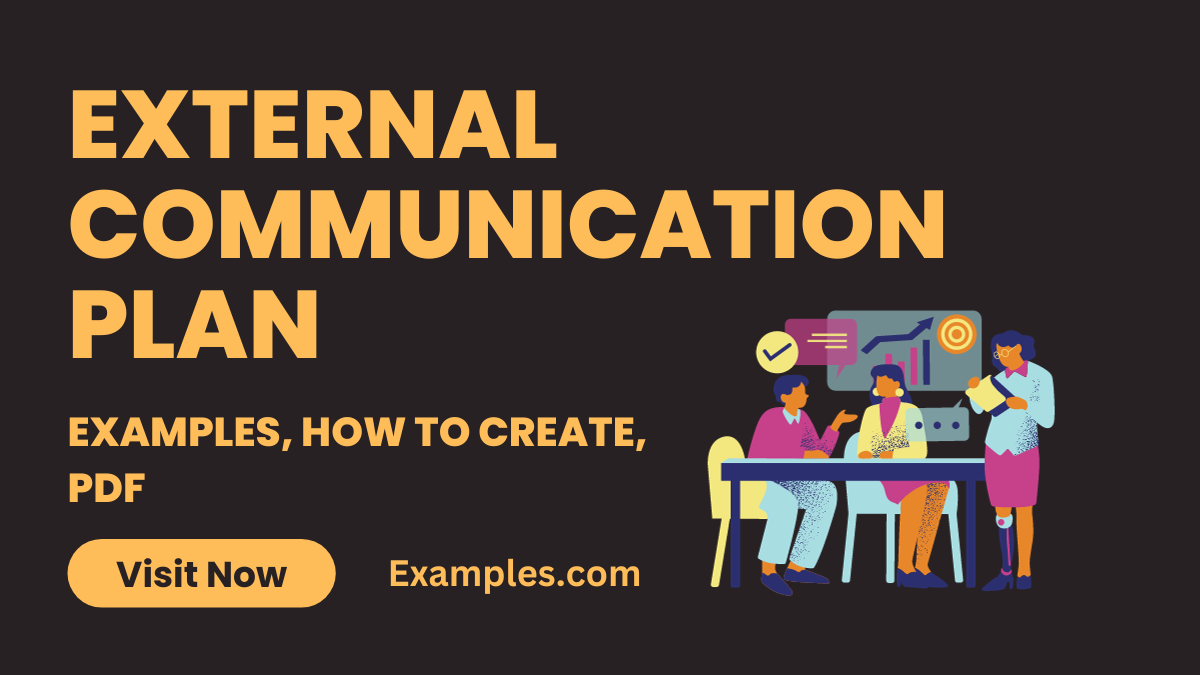5+ External Communication Plan Examples
Dive into our comprehensive guide on External Communication Plans, a crucial tool for any successful organization. Discover a variety of real-world communication examples, illustrating how strategic messaging can forge stronger connections and drive your objectives forward. This guide not only demystifies the concept but also enriches your understanding with practical examples, ensuring you’re well-equipped to craft and implement an effective communication strategy. Embrace the power of clear, impactful external communication today!
Download External Communication Plan Bundle
External Communication Plan
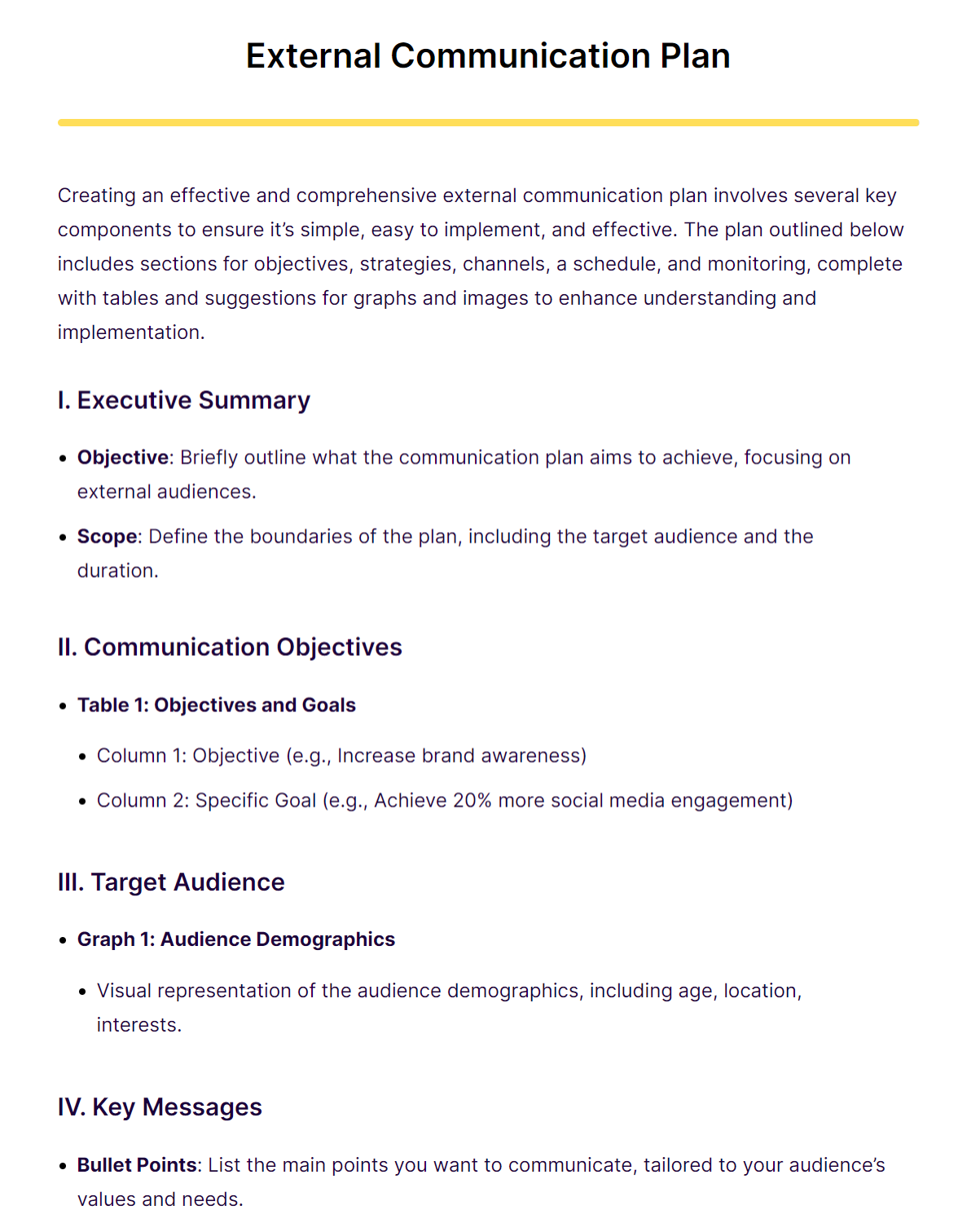
The creating an effective external communication plan. It covers essential components like setting objectives, identifying target audiences, crafting key messages, and selecting appropriate channels and tools. The plan includes practical tables and graphs for visual representation, offering a comprehensive approach to implementation, budgeting, monitoring, and risk management. It emphasizes the importance of clarity, consistency, and flexibility in communication strategies, providing a valuable resource for organizations aiming to enhance their external communications.
External Stakeholder Communication Plan
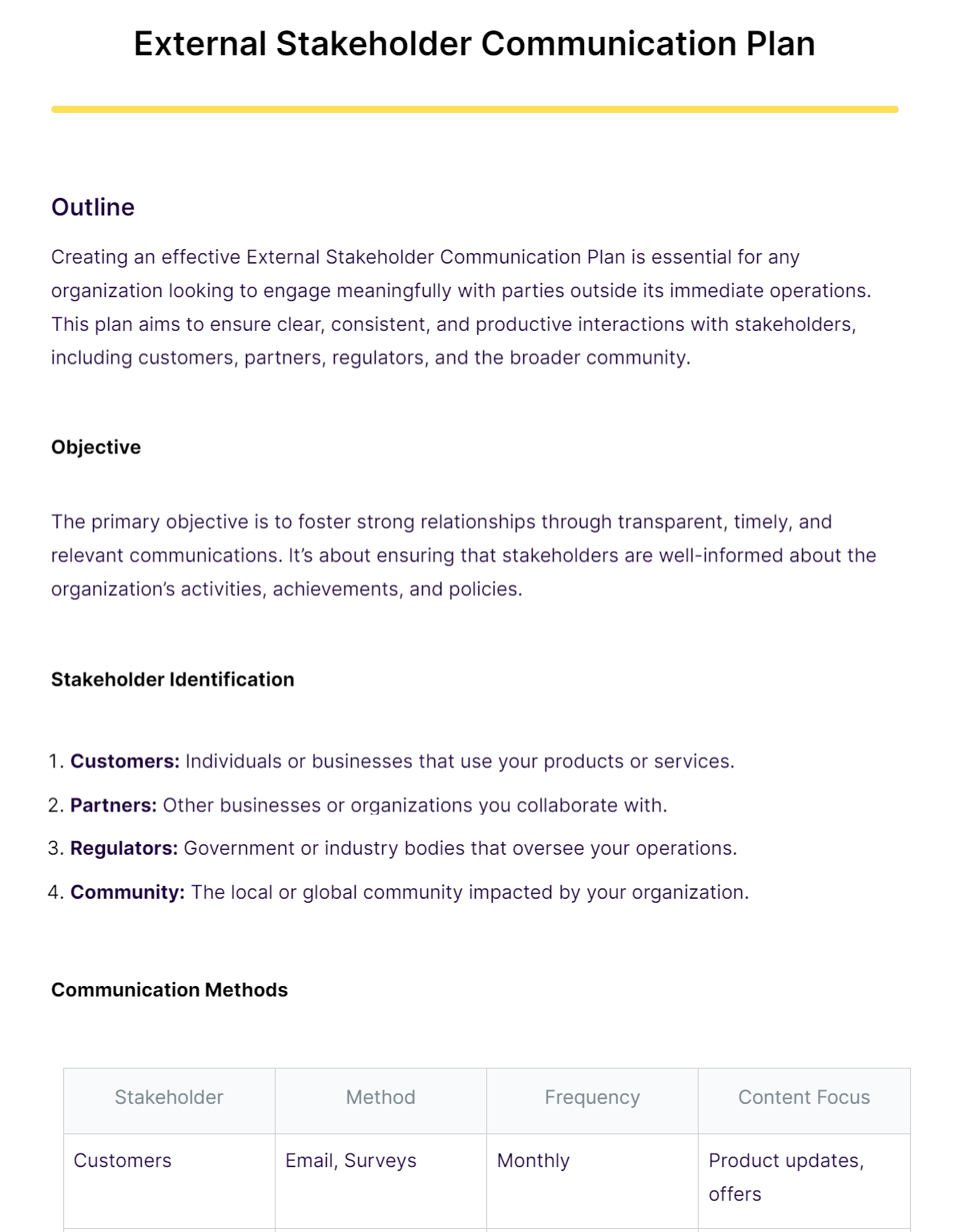
The External Stakeholder Communication Plan. It outlines steps to effectively communicate with key external parties such as customers, partners, regulators, and the community. The plan covers objectives, stakeholder identification, communication methods, key messages, responsibility assignments, and monitoring strategies. It emphasizes transparency, responsiveness, and accountability in stakeholder interactions, providing a framework for building strong relationships and maintaining a positive organizational reputation.
External Communication Management Plan
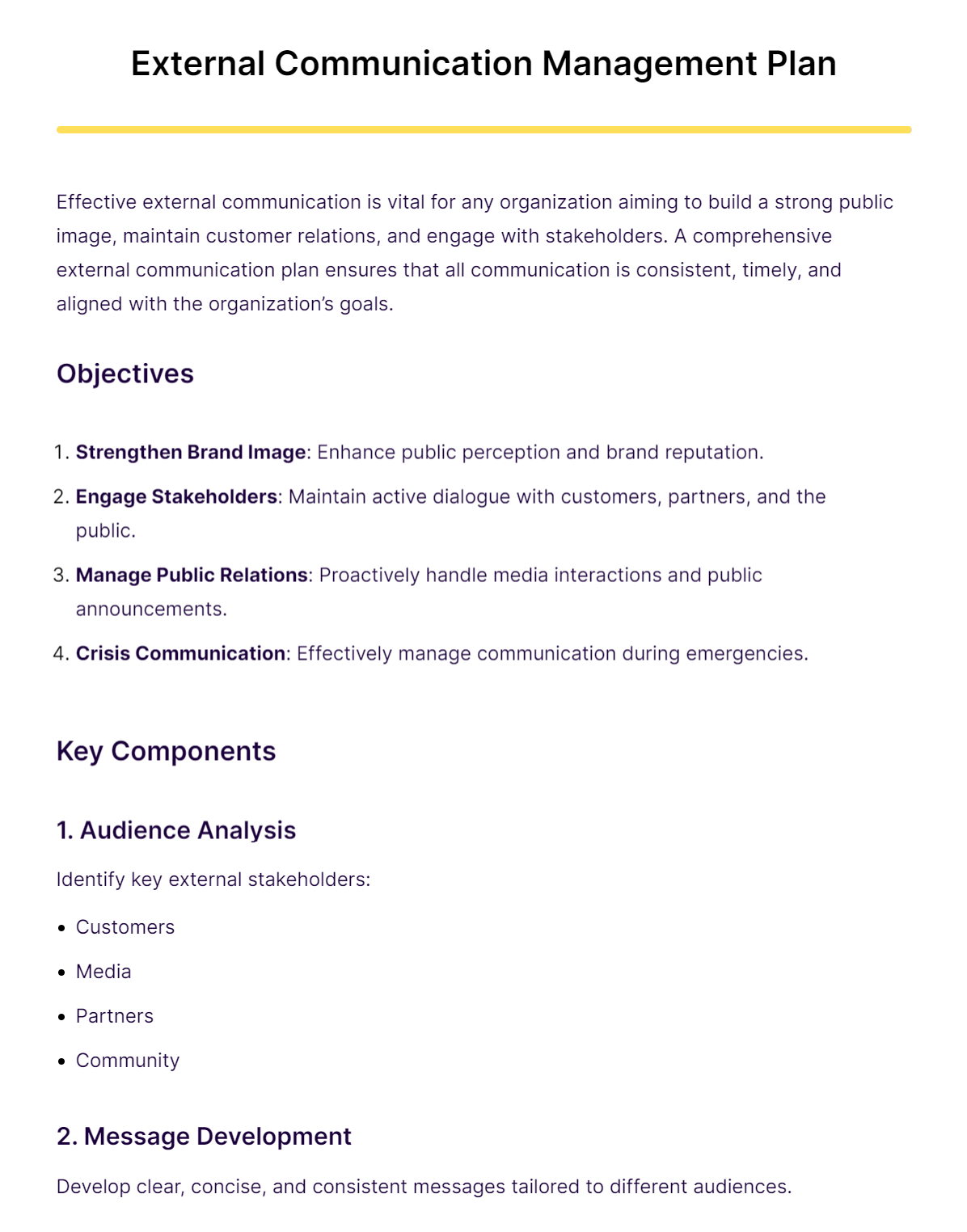
The effective external communication management plan. It outlines key objectives such as strengthening brand image, engaging stakeholders, managing public relations, and crisis communication. The plan includes audience analysis, message development, choice of communication channels, and a detailed communication schedule. It also emphasizes the importance of monitoring, feedback, and having a crisis communication strategy, making it a comprehensive resource for organizations aiming to improve their external communications
External Audit Communication Plan

The creating an external audit communication plan. It details how to establish a structured framework for interactions between an organization and its external auditors. The plan emphasizes the importance of clear objectives, identifying key stakeholders, utilizing various communication tools, and outlines distinct phases of communication during the audit process. It also highlights best practices like regular updates, clear documentation, prompt responses, and ensuring confidentiality
External Network Communication Plan
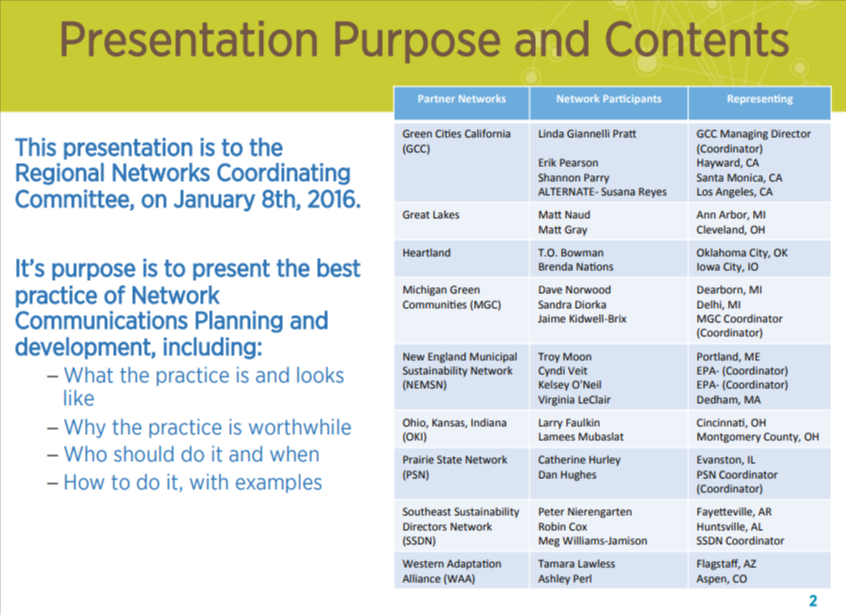
usdn.org
DownloadExternal Integrated Marketing Communication Plan
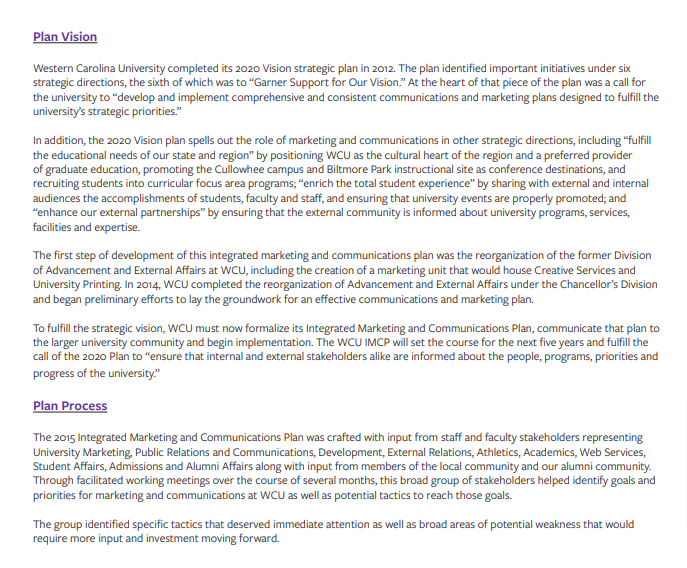
wcu.edu
DownloadHow to Create an External Communications Plan?
Developing an effective Communications Plan is essential for ensuring your organization’s message is clearly understood and well-received by external audiences. This guide outlines a step-by-step approach to creating a plan that is both comprehensive and effective.
- Step 1: Define Your Objectives: Begin by identifying what you want to achieve with your external communications. Communication objectives might include increasing brand awareness, launching a new product, or managing your organization’s reputation. Be specific and ensure these objectives are measurable.
- Step 2: Identify Your Audience: Understanding your audience is critical. Determine who your external stakeholders are. This can include customers, partners, media, and the general public. Segmenting your audience based on their interests and needs will help tailor your communication more effectively.
- Step 3: Develop Key Messages: Craft key messages that align with your objectives and resonate with your audience. These messages should be clear, concise, and consistent across all communication channels. Ensure they reflect your organization’s values and mission.
- Step 4: Choose the Right Channels: Select appropriate channels for delivering your message. This could include social media, press releases, email newsletters, or public events. The choice of channels should align with where your audience is most active and receptive.
- Step 5: Plan Your Content: Develop a content strategy that supports your key messages. Plan the type of content you will create, such as blog posts, videos, or infographics, and how it will be distributed across your chosen channels.
- Step 6: Set a Timeline: Create a timeline for your communications plan. This should include key dates for content release, promotional activities, and any other significant events that align with your objectives.
- Step 7: Allocate Resources: Determine the resources required to implement your plan. This includes budget, personnel, and technology. Ensure you have the necessary support to execute the plan effectively.
- Step 8: Monitor and Adjust: Once your plan is in action, continuously monitor its performance. Use metrics such as engagement rates, website traffic, or media coverage to assess effectiveness. Be prepared to make adjustments to optimize the plan as needed.
- Step 9: Review and Report: Regularly review the overall performance of your external communications plan. Analyze what worked well and what could be improved. Share these insights with key stakeholders and use them to inform future planning.
What’s included in this External Communication Plan Template?
Crafting an External Communication Plan is vital for any organization looking to engage effectively with its audience. This comprehensive guide is designed to ensure your plan is not only optimized for “External Communication Plan” , ensuring maximum reach and understanding. Here’s what’s included in this template:
- Objective Setting: Understanding and defining clear objectives is the cornerstone of any effective communication plan. This section helps you articulate what you want to achieve, such as increasing brand awareness, improving public perception, or driving specific actions from your audience.
- Stakeholder Identification: Identify who your external stakeholders are. These could include customers, partners, investors, community groups, and the media. Understanding their needs and expectations is crucial for tailoring your communication strategy.
- Key Messages: Develop clear, concise, and impactful messages that resonate with your external stakeholders. This part of the template guides you in creating compelling content that aligns with your objectives and stakeholder expectations.
- Communication Channels and Tools: Selecting the right channels and tools is essential for reaching your audience effectively. This section helps you choose the appropriate mediums — be it social media, press releases, newsletters, or public forums — based on your stakeholders’ preferences and habits.
- Content Calendar: A well-organized content calendar is vital for timely and consistent communication. This part of the template assists in planning and scheduling your messages, ensuring a steady and strategic flow of communication.
- Monitoring and Evaluation: To gauge the effectiveness of your external communication efforts, this section focuses on setting up KPIs and feedback mechanisms. It guides you in measuring engagement, sentiment, and the overall impact of your communication strategies.
- Budget Planning: Effective communication doesn’t happen without cost. This part helps you outline the budget required for each aspect of your plan, ensuring you allocate resources wisely and get the best return on investment.
- Risk Management: Prepare for potential communication crises or negative feedback by setting up a risk management plan. This section includes strategies for rapid response, message control, and reputation management.
- Roles and Responsibilities: Clearly define who in your team is responsible for each part of the communication process. This ensures accountability and helps your plan run smoothly.
- Legal and Ethical Considerations: Navigate the legal and ethical landscape of external communication. This part ensures that your communication strategies comply with laws and ethical standards, protecting your organization and stakeholders.
What is an Example of External Communication Plan?
An external communication plan is a strategic blueprint that businesses use to convey messages to parties outside their organization, such as clients, investors, or the general public. It’s designed to deliver clear, consistent, and effective messages that align with the company’s goals and brand image. Below is a detailed guide to an example of an external communication plan, optimized for the term “External Communication Plan”.
Key Elements of an External Communication Plan
- Objective Setting: Any plan starts with clear objectives. For an external communication plan, objectives might include increasing brand awareness, managing a company’s public image, or effectively handling crisis communication.
- Target Audience Identification: Knowing the audience is crucial. A plan might target customers, investors, the media, or other stakeholders. Each requires tailored messages and channels.
- Message Development: The core of the plan is the message. What does the company want to convey? Messages should be compelling, clear, and aligned with the company’s values and objectives.
- Channel Selection: Choose the right channels to reach the audience. Options might include social media, press releases, public events, or email campaigns.
- Timeline and Budget: Detail when communications will occur and estimate the costs involved. This helps in planning and resource allocation.
- Monitoring and Evaluation: Set up methods to track the effectiveness of the communication. This might involve analyzing engagement metrics or collecting stakeholder feedback.
A Practical Example of an External Communication Plan
- Objective: Generate excitement and awareness about the new product.
- Target Audience: Current customers, potential customers, tech enthusiasts, and industry influencers.
- Message: Highlight the unique features and benefits of the product, and how it addresses specific user needs.
- Channels: Use social media for broad outreach, press releases for media coverage, and targeted emails to current customers.
- Timeline and Budget: Plan a series of communications leading up to and following the product launch, with allocated budget for each channel.
- Monitoring and Evaluation: Use social media analytics, media mentions, and product pre-orders as indicators of the plan’s success.
External Communication Plan Strategy
An External Communication Plan Strategy is a systematic approach organizations use to convey messages, information, and company values to audiences outside their immediate business environment. This includes customers, partners, investors, the media, and the public. A well-crafted external communication plan strategy is vital for maintaining a positive public image, building brand awareness, and fostering trust and loyalty among stakeholders.
Understanding the Core of External Communication
At its core, external communication is about delivering the right message to the right people at the right time. It involves a series of coordinated efforts and tools designed to effectively reach and engage external audiences. The strategy outlines the what, when, how, and to whom of messaging, ensuring that all communication efforts are cohesive, consistent, and reflective of the organization’s objectives and values.
Components of an Effective External Communication Plan Strategy
- Audience Analysis: Understanding who your stakeholders are and what they care about is fundamental. Tailoring your message to meet their needs and expectations can significantly impact the effectiveness of your communication.
- Clear Objectives: Define what you want to achieve with your external communication. Objectives can range from enhancing brand perception, managing crises, promoting new products or services, or simply engaging with the community.
- Key Messaging: Develop clear and concise messages that resonate with your audience and reflect your brand’s values and mission. Consistency in messaging helps in reinforcing brand identity and ensures clarity.
- Channels Selection: Choose the appropriate channels to reach your audience. These can include social media, press releases, emails, public events, or traditional media. The choice should align with where your audience is most active and receptive.
- Content Plan: Create a content strategy that outlines what will be communicated, in what format, and when. This can include a mix of promotional content, informative articles, press releases, and social media posts.
- Monitoring and Feedback: Implement tools and procedures to monitor the effectiveness of your communication efforts and gather feedback. Understanding public perception and engagement can help in refining and improving your strategy.
- Crisis Communication: Prepare for potential negative situations with a crisis communication plan. This should include protocols for rapid response, key contacts, and predefined messages to mitigate damage and maintain trust.
The article from Sogolytics discusses key questions for an external communication audit, emphasizing the importance of evaluating how an audience perceives and interacts with an organization’s communication. Key areas include satisfaction with communication received, its effectiveness, usefulness, preferred content and frequency, and overall perception of the organization based on communication. These aspects are crucial for understanding and improving how external communication is managed and perceived.
The USC article discusses the importance internal communication strategies in business. It highlights that effective communication is crucial for conveying business strategies to employees and stakeholders. The article emphasizes the role of communication in ensuring that everyone in an organization understands and supports key goals and values. It also addresses the impact of external communication on a business’s reputation and customer engagement. For a comprehensive understanding of these strategies and their implementation.



